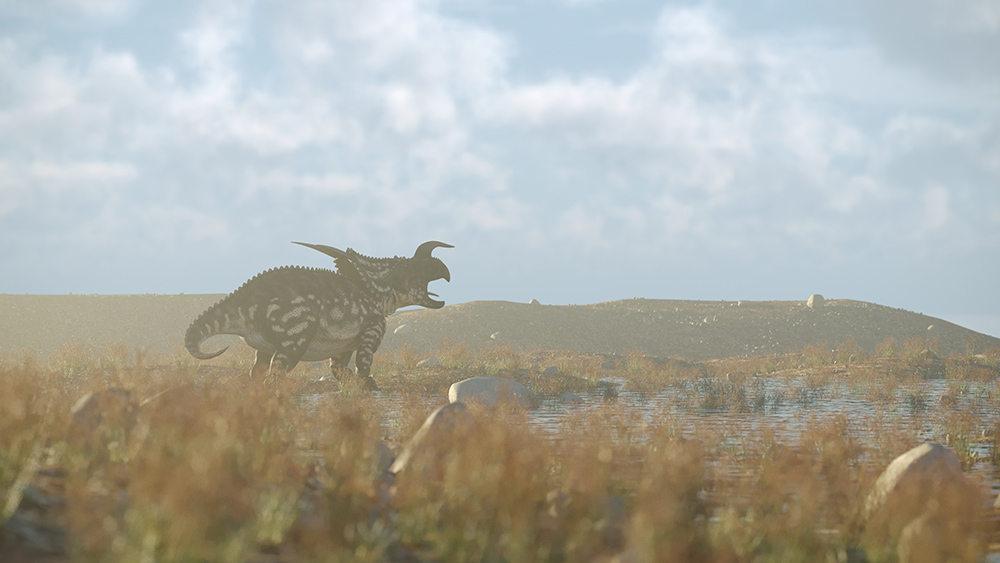Creation-based thinking made a testable prediction. If Noah’s Flood formed dinosaur and other fossils only 4,500 or so years ago, then they may still contain measurable amounts of the short-lived radioactive isotope carbon-14—also called radiocarbon. On the other hand, any fossil deposited before the limit of carbon-14 longevity (around 100,000 theoretical years ago) would have no carbon-14 left. Now, a team of secular scientists used radiocarbon to argue against the preservation of dinosaur collagen, but unwittingly affirmed the Flood option.
Examples of radiocarbon discoveries that are out-of-place for evolutionary time keep stacking up. Medical doctor Paul Giem accumulated dozens of examples back in 2001.1 His long list of secular publications cited radiocarbon in coal, oil, and marble. It inspired the ICR RATE project to look for radiocarbon in deeply buried coal and in supposedly ancient diamonds. RATE found radiocarbon at levels above the background blanks in all samples.2,3
In our 2015 report of new fossil samples with radiocarbon, coauthor Vance Nelson and I summarized a few dozen already published wood, shell, and bone fossils that bore evolutionary ages far in excess of their radiocarbon levels.4 That list had almost fifty samples. Now, a Chicago Field Museum-led team published one more in the journal eLife.5
It seems as though almost everywhere we look, we find young-looking carbon.
The eLife study authors carefully excavated a bone from a ceratopsian called Centrosaurus apertus found in the Dinosaur Park Formation of Alberta, Canada. The radiocarbon lab then used a protocol to extract the organic fraction, but not the standard protocols that remove the humic acids that could have come from modern soil contaminants.6 The team reported radiocarbon in units called F14C, which refers to the fraction of modern radiocarbon. Their result of 0.0149 translates to about 33,790 carbon years old.7
This falls right in the middle of values from other Cretaceous fossils.8 In other words, even without using the strictest pretreatments, they obtained results that look just the same.
The eLife authors assumed that all that Centrosaurus radiocarbon must be contamination from recent carbon that somehow naturally injected into the bone, perhaps by microbes. They wrote, “As the C in the dinosaur bone is not radiocarbon dead, this suggests an influx of more modern C (i.e., not radiocarbon dead) into the fossil.” Or, it could suggest that the fossil is young.
They offered no evidence for the influx hypothesis, but merely asserted it based on their assumption of 75 million years for the Centrosaurus. They reason that since something that old can no longer have radiocarbon, therefore all of the sample’s measured radiocarbon must have come from modern sources. But where would all that recent radiocarbon come from? How would it get inside, then become part of, the bone? If that much modern radiocarbon can go that deep and that recently, then how can we trust any radiocarbon result? And why would the standard pretreatment used at the University of Bristol’s radiocarbon lab fail to remove contamination—the very basis for using radiocarbon to make age estimates for archaeological samples? The study authors addressed none of these crucial challenges.
ICR physicist Jake Hebert’s words from 2013 seem more appropriate today than ever:
With young-looking radiocarbon in over 60 supposedly millions-of-years-old fossils,8 plus this new Centrosaurus, the contamination excuse is starting to look silly.
References
1. Giem, P. 2001. Carbon-14 Content of Fossil Carbon. Origins. 51: 6-30.
2. Baumgardner, J. 2005. Carbon-14 Evidence for a Recent Global Flood and a Young Earth. In Radioisotopes and the Age of the Earth: Results of a Young-Earth Creationist Research Initiative. Vardiman, L., A. A. Snelling, and E. F. Chaffin, eds. San Diego, CA: Institute for Creation Research and Chino Valley, AZ: Creation Research Society, 587-630.
3. A background blank is a standard reference sample of carbon assumed to have no radiocarbon. Also called carbon dead, Earth materials like coal and graphite have found use as background blanks, even though they all appear to contain radiocarbon detectable at levels above theoretical instrument detection limits. Radiocarbon labs do not generally release carbon date results for samples that have less radiocarbon than their chosen background blanks.
4. Thomas, B. and V. Nelson. 2015. Radiocarbon in Dinosaur and Other Fossils. Creation Research Society Quarterly. 51 (4): 299-311.
5. Saitta, E. T. et al. 2019. Cretaceous dinosaur bone contains recent organic material and provides an environment conducive to microbial communities. eLife. 8: e46205.
6. They merely used acid to eliminate carbonates, whereas standard acid-base-acid washes eliminate both carbonates and humic acids. Humics are organic degradation products from modern soils that may or may not have been present in the Centrosaurus. By allowing humics to remain, their protocol opened the door to traces of modern radiocarbon to contribute to the total count. This slanted approach fit their agenda that bacteria, fungi, or other modern contaminants produced both the young-looking radiocarbon in their sample and the young-looking collagen in dozens of other published samples.
7. It’s no problem to adjust these carbon years to biblical calendar years by, for example, factoring in a much larger pre-Flood biomass (which would dilute F14C) and a much stronger pre-Flood magnetic field (which would reduce 14C production), but it’s a huge problem to reconcile these carbon years to tens or hundreds of millions. See Cupps, V. R. Radiocarbon Dating Can’t Prove an Old Earth. Acts & Facts. 46 (4): 9.
8. Thomas, B. 2017. Young Radiocarbon in Old Samples. Acts & Facts. 46 (11): 9.
9. Hebert, J. 2013. Do Young C-14 Results Reflect Contamination? Acts & Facts. 42 (7): 20.
Stage image: Einiosaurus, a ceratopsian
*Dr. Brian Thomas is a Research Associate at the Institute for Creation Research.













